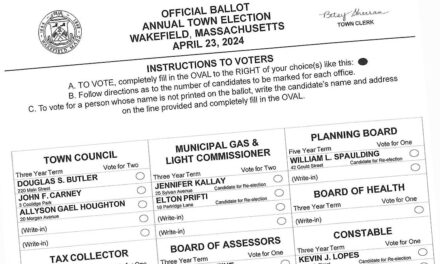Published in the April 29, 2021 edition.
By MARK SARDELLA
WAKEFIELD — Wakefield’s Natural Hazard Mitigation Plan was created to assist the Town in mitigating losses from natural hazard events and identify areas of potential improvement. Originally developed by town personnel in 2007, the plan was updated in 2019 by the town with the assistance of its consultant, BETA Group, Inc. (BETA) to reflect changes in critical facilities, hazards and the mitigation efforts required to protect these facilities against the identified hazards.
DPW Director Joseph Conway appeared before the Town Council this week to seek approval of the final version of the Hazard Mitigation Plan. He reminded the board that a draft of the plan had been presented to the Town Council by the DPW and BETA Group in June of 2019.
Since then, the plan has been submitted to the Federeal Emergency Management Administration (FEMA) and the Massachusetts Emergency Management Administration (MEMA), Conway said.
The 2019 version of this Hazard Mitigation Plan was revised in early 2020 to incorporate the results of a vulnerability assessment developed as part of the Massachusetts Executive Office of Energy and Environmental Affairs’ Municipal Vulnerability Preparedness (MVP) grant program. The MVP additions to this Plan are focused on enhancing Wakefield’s resilience to a changing climate. While all four hazards identified through the MVP process were also included in the Hazard Mitigation Plan process, the MVP lens looks at both past trends and future projections, based on climate science.
Otherwise, Conway said, the the plan presented this week was substantially the same as the one presented in June 2019. He said that he was seeking the Town Council’s endorsement of the plan as approved by FEMA so that the DPW and the town can begin applying for some of the federal grant programs available.
The following natural hazards were discussed during the process of creating the Hazard Mitigation Plan: winter storms, nor’easters, hurricanes/tropical storms, high winds, dam failures, ice storms, drought, extreme temperatures, invasive species, earthquakes, thunderstorms, tornadoes, wildfires and urban fires.
The Wakefield Hazard Mitigation Team identified 156 critical facilities within the town that fall into various categories, including town departments, infrastructure, businesses and other institutions deemed critical.
This plan identifies natural hazards impacting the town of Wakefield, assesses the town’s vulnerability to these hazards and recommends actions to mitigate the effects identified hazards may have on the town. This Hazard Mitigation Plan has been prepared based on FEMA’s “Local Mitigation Planning Handbook” (March 2013) and was designed to meet the requirements of the Disaster Mitigation Act of 2000 (DMA 2000) enacted by Congress on October 10, 2000.
The Town of Wakefield has received a FEMA Hazard Mitigation Planning Grant (HMGP) from MEMA to update the Hazard Mitigation Plan. Wakefield and BETA developed this Plan to focus specifically on the local issues affecting the town.
According to the Hazard Mitigation Plan, the goals of the Town of Wakefield with respect to Natural Hazard Mitigation are:
1. To improve upon the protection of the residents, businesses and Town Infrastructure from natural hazards.
2. To reduce the potential impact of natural hazards on critical facilities within the town of Wakefield.
3. To improve upon emergency preparedness by identifying potential areas of concern prior to a natural hazard event and determining appropriate actions to mitigate impacts.
4. To identify and implement cost effective mitigation measures to reduce future impacts.
Based on the Town ‘s ranking of each category, an overall risk assessment for each hazard was determined.
The four hazard categories identified as most likely to significantly impact Wakefield are: Nor’easters, high winds, hurricanes/tropical storms and winter storms. Given Wakefield’s geographical location as an inland community with no significant elevation changes or historic records of erosion or landslides, these two hazards were briefly discussed but it was determined there is no risk for these two events and they were not included in further discussions for the risk summary.
All natural hazards have the potential to cause property damage and loss of human life, as well as limit access to essential services in a community, including potable water, wastewater collection, and electrical power.
Wakefield identified several natural hazards that have occurred or could occur in town and analyzed the hazard risk for each. The MVP process enhanced the hazard identification process. Preparing for the MVP workshops involve pulling from State climate data, reviewing existing town documents and technical information, and identifying the four most significant climate hazards facing Wakefield.
The team landed on drought, flooding, heat waves, and intense storms. Analysis for the Hazard Mitigation Plan included determining the likely frequency, severity, and area of impact for each hazard.
Current and recommended mitigation strategies for each potential hazard are detailed at length in the Hazard Mitigation Plan.
According to the plan, the largest impediment to implementing additional mitigation actions is funding. Funding through local revenues as well as seeking opportunities through grant and loan programs needs to be increased to effectively increase the current mitigation capabilities of the town, the plan concludes.
The Town Council vote to approve the Hazard Mitigation Plan was unanimous.




